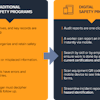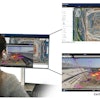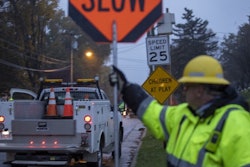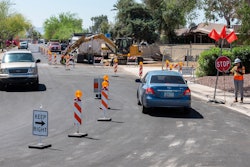
In the dynamic world of building and construction, ensuring operational safety and efficiency while minimizing disruption is paramount. Often the optimization of project ROI is not just about labor, material and equipment costs, but also the strategic planning and execution of effective traffic management strategies. Read on to learn about the critical aspects of work zone safety, from design to implementation, highlighting best practices to protect people and progress.
Minimizing Disruptions
Especially for construction projects intersecting with or on roadways or heavily trafficked areas, proficient traffic management is essential. It involves planning work schedules around peak traffic times; providing clear and timely information to the public; and the strategic deployment of signage, barriers, and designated pathways and detours.
Work disruptions invite delays, cost overruns and a negative public perception. Implementing several best practices can help maximize the return on investment (ROI) through efficient work zone management and minimize disruptions:
- Always plan—Identify potential challenges early in the planning process. This allows for the swift development of comprehensive strategies to tackle them.
- Seek stakeholder alignment—Collaboration with local authorities, transportation agencies and the public helps ensure that plans are realistic, effective and minimally disruptive.
- Take a safety-first approach—Emphasize safety in every plan. Doing this involves integrating optimal methods for barrier positioning, signage deployment and pedestrian route design.
- Maintain clear communication—Keep the public informed about construction schedules and traffic changes requires a combination of signage and public announcements.
- Conduct regular reviews—Continually assess the effectiveness of work zone measures and remain adaptable to evolving conditions. This is vital for safety.
Planning for Success
The planning phase lays the foundation for smooth integration between construction activities and traffic flow. A carefully crafted plan considers project duration, anticipated traffic volume and site-specific needs determined by a comprehensive analysis of traffic impact and associated risks. Factors to be included in the plan are:
- Traffic impact analysis—This thorough analysis offers insights into potential bottlenecks, detour requirements and the best scheduling of construction phases during peak traffic hours. Advanced modeling tools also predict how activities will impact traffic flow, including forecasting potential congestion locations.
- Risk assessment—A detailed risk assessment identifies the hazards associated with different phases of construction including the interface between machinery and vehicular/pedestrian traffic. This will extend to considerations for emergency access and environmental factors including terrain, vegetation weather conditions and bodies of water.
Collectively these efforts help avert accidents and injuries. Allocating resources toward thorough traffic management planning isn't merely an expenditure. It is a strategic investment that helps safeguard the project's financial stability.
Training for Workers & Management
The success of traffic management strategies hinges on the knowledge and competence of the workforce. Comprehensive training programs for workers and management are essential to ensure that all personnel are familiar with safety protocols.
 Safety is non-negotiable.Victor, AdobeStock
Safety is non-negotiable.Victor, AdobeStock
When assessing training programs, give priority to three criteria. The first is a customized curriculum. Tailoring programs to address the needs and risks of individual construction projects is crucial. For example, urban settings can present different challenges such as higher congestion and intricate road networks with multiple lanes and crossings. On the other hand, rural roads see less pedestrian activity and feature narrower lanes, limited shoulders and fewer traffic control devices. Training should acknowledge these distinctions and concentrate on the types of work commonly undertaken in each setting.
Engagement and interaction are also important. Active engagement and interactive training methods, such as hands-on simulations, role-playing and group discussions, have been shown to significantly improve retention rates and understanding of complex safety concepts.
Continuous learning must also be part of the training process. Safety is not a one-time event but a continuous process. Regular refresher courses, updates on new regulations and post-incident reviews are essential to keep the workforce informed and vigilant.
Management's involvement in safety training is pivotal. Leaders should participate in comprehensive training themselves and advocate for safety initiatives, emphasizing the significance of compliance and encouraging a culture that values well-being more than expedience or cost-cutting measures. Management can reinforce the priority of safety in the following ways:
- Leading by example—When management actively participates in safety training and adheres to best practices, it sets a powerful example for the entire workforce, reinforcing the message that safety is non-negotiable.
- Resource allocation—Management also bears the responsibility of ensuring the adequate allocation of resources for comprehensive training programs. This encompasses provision of time, financial support and access to high-quality training materials and expertise.
- Policy development and enforcement—Developing clear safety policies is crucial, but these are only as effective as their enforcement. Management must be diligent in enforcing safety standards and holding all team members accountable for compliance.
Best Practices for Optimal Outcomes
Maintaining safety within work zones requires a combination of physical and procedural measures. Best practices include the regular inspection and maintenance of barriers and signage to ensure their effectiveness, the implementation of speed reduction measures within the work zone, and the provision of clear, continuous communication to all personnel and motorists regarding safety procedures and any changes in the work environment.
To help ensure the success of traffic management efforts, construction professionals should adhere to several best practices:
- Display clear signage—Ensure the use of clear signs to indicate restricted areas, speed limits, detours and other important information along the route.
- Have an emergency plan—Developing and disseminating clear emergency response plans, including evacuation routes, assembly points and procedures for dealing with different dangers, are imperative to safeguard workers.
- Daily safety briefings—Start each shift with a toolbox talk, a briefing to address potential hazards, reinforce emergency protocols and share experiences that can teach everyone how to work safer and smarter. These toolbox talks also help foster a culture of teamwork where everyone looks out for each other's well-being.
- First aid and medical access—Ensuring the availability of first-aid supplies and trained personnel onsite, along with clear protocols for accessing medical facilities in case of serious injuries, is important.
- Evaluation and feedback—Regularly evaluate the effectiveness of traffic management strategies and seek feedback from workers, stakeholders and the public. This iterative process promotes continuous improvement and enhances the efficacy of future traffic management plans.
- Continuing education—Arrange for workers and management to participate in safety workshops and seminars to enhance their knowledge.
 Clear signs to indicate restricted areas, speed limits, detours and other important information along the route are critical.Lawr, AdobeStock
Clear signs to indicate restricted areas, speed limits, detours and other important information along the route are critical.Lawr, AdobeStock
Enhancing the ROI for construction activities requires a comprehensive strategy that includes a plan for effective traffic management. By streamlining operations and reducing risks, companies not only safeguard their teams and the general public but also stand to boost productivity. In the long run, this investment contributes to the immediate success of a project and can bolster a company's reputation for reliability and safety, paving the way for future business opportunities.




















